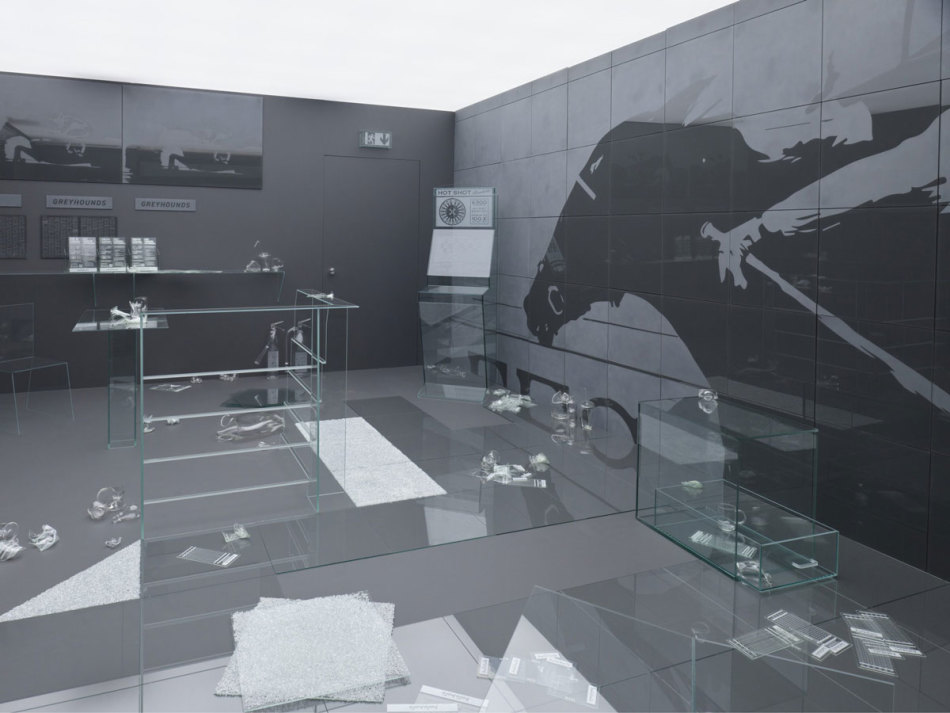Five minutes with Ryan Gander RA
Five minutes with Ryan Gander RA
By Ravi Ghosh
Published 13 June 2022
From a striking coastal sculpture to a life-size betting shop made entirely of glass, artist Ryan Gander RA’s practice is brilliantly varied. Get to know the life and work of the newly elected Royal Academician.
-
From the Summer 2022 issue of RA Magazine, issued quarterly to Friends of the RA.
Ravi Ghosh is a journalist and critic. He works for Elephant magazine.
-
His father built cars
Ian Gander worked as an engineer at a Vauxhall assembly plant in Ellesmere Port, Cheshire, and would often come home with advice for his young son. “He told me that if you do a job that’s varied, that you like doing, then you’ll never work a day in your life,” Gander recalls. Does being a conceptual artist meet those criteria? Yes, is his short answer.
Although he works across sculpture – the category in which he was recently elected to the Academy – as well as text, performance, graphic design and more, imagination is his most powerful tool, honed during a youth spent in hospitals. “When you’re socialised in an institution by adults – and you’re stuck in a bed – your mind becomes your most active muscle,” he says. “When people would go places that I couldn’t physically access, I’d imagine them instead.”
-
When people would go places that I couldn’t physically access, I’d imagine them instead.
Ryan Gander RA
-
His practice is constantly evolving
Gander sews and loves to paint, but his practice focuses on concept, not execution. He marvels at the skill of the glassblowers and designers who worked on Ghost Shop (2022). This Glass Exchange commission recreates an abandoned betting shop in Sunderland entirely from glass – right down to old newspapers and fire extinguishers – as a comment on the ubiquity of bookmakers and stigma of gambling addiction.
But Gander sees himself as a restless conductor. “I can’t be fetishistic about craft,” he reflects. “I can’t let my enjoyment of one material influence what I do.” This leads to a constantly evolving practice. He cites his father again, who would wonder why most artists create the same work in repetition, like a car assembly line.
A true multidisciplinary practice, Gander explains, spans media traditionally seen as separate to art: children’s books, music videos, designing a kitchen sink (Gander did them all in one year). “Art is the only place in the social fabric of humanity where you can do anything at all,” he says. “You’re never deemed weird or illicit; it’s this real space of openness.”
-

Ryan Gander, Ghost Shop, 2022.
-
His works are ‘incomplete’
Another new public artwork is We are only human (Incomplete sculpture for Scarborough to be finished by snow), a concrete dolos (a form usually used to slow coastal erosion) sitting on Scarborough Castle’s headland, as part of Yorkshire’s new Wild Eye sculpture trail. As its title suggests, the sculpture embodies Gander’s resistance to closure and determination that value lies in the afterlife of the artwork. “The general principle of really great art – of history-changing art – is for works to have as many possible answers that are all equally valid,” he says. As an example, he cites Cornelia Parker RA and her long-term project to send a meteor back into space. “When the viewer is on the bus home and they’re still thinking about the work, that’s art.”
-
He uses humour to make art accessible
The way things collide (condom, meet USM cabinet) (2012) is a beech cabinet with a condom carved into the top; I is… (v) (2013) is a marble den inspired by his young daughter; and his series with mice, such as ‘The End’ (2020), see animatronic rodents emerge from gallery walls talking metaphysics. “Strategies like humour, intrigue, romance and confusion make my work accessible,” says Gander. An artist must be in complete control of their visual language to achieve this, he adds, with “an absolute understanding of signifiers and of manipulating semiotics.”
-

Ryan Gander photographed in his Suffolk studio, in April 2022, by Benjamin McMahon
-
He is not a disabled artist
Gander uses a wheelchair, but rarely references disability in his work (an exception is 2011’s The Artwork Nobody Knows, a sculpture depicting a man lying beside a toppled wheelchair, shown at the 54th Venice Biennale). Gander identifies with not being disabled, he says, something he has had to explain more frequently as his career has progressed. “I don’t even feel disabled,” he says. “I’ve spent my whole life trying not to be disabled, so I don’t want to be labelled a “disabled artist.”’
-
He values community over the individual
We are living in the age of the self, Gander says, making conceptual work less appealing than identity-led art. His talking mouse in I… I… I… (2019) speaks only those eponymous words, a comment on the inwardness that society encourages today. Gander refers to his father Ian again, who noticed that, in his creative writing workshop, everyone wanted to read their own stories rather than listen to other people’s. But in reality, “all the good things come from collectivity: friends, family, society,”’ Gander says. What we share overwhelms our differences.
-
-

Enjoyed this article?
Become a Friend to receive RA Magazine
As well as free entry to all of our exhibitions, Friends of the RA enjoy one of Britain’s most respected art magazines, delivered directly to your door. Why not join the club?
-






